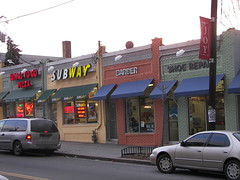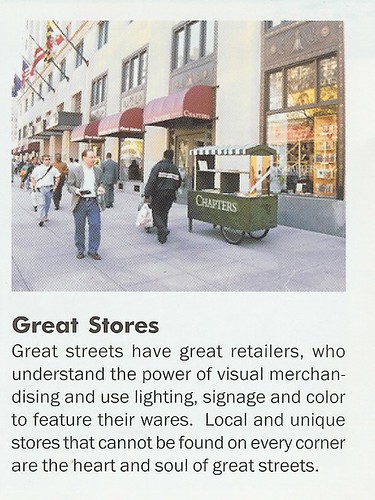Now I'm in for it

New painting on the 3500 block of 12th Street NE, west side, Brookland.
I am officially the interim program manager for the Brookland Main Street program in Washington, DC. If I want the job permanently, I will have to re-apply for the position, as it will be posted.
But, I'm in for it, not just locally, but nationally, because I opine plenty about how people should be doing commercial district revitalization.
Just recognize, urban revitalization takes a fair bit of time, as Neal Peirce points out in this column from 2004, "MAIN STREET NICHES IN A MASS SALES WORLD."
To get a sense for the foundation of my approach, see these posts:
-- The soft side of commercial district competition
-- Nurturing independent businesses through creatively reducing capital requirements
-- Commerz in the 'hood, part three
-- To get independent businesses you need to rebuild the supporting infrastructure
which are undergirded by my thinking about the Reilly Law of Retail Gravitation which focuses on measurable indicators--the number and mix of stores in particular shopping destinations. The Law is that with factors being roughly equal (travel, etc.) people will choose the shopping center/option that is better (more and more interesting stores, variety of product selection, etc.). Obvious huh? In the urban context especially, factors that people mull over when deciding between shopping destinations include comfort and perceptions of safety, physical condition of the commercial district, etc.
This is why I joke about Main Street principles #9 and #10 (there are officially only 8 principles)--knowing what you have (or not) and being honest about it; and making the hard choices you need to make in order to improve.
As long as a particular urban commercial district is deficient compared to nearby shopping alternatives, it won't be able to attract new customers, until it starts providing some decent options. That's why I always write about the importance of restaurants, places like Banana Cafe on 8th Street SE, which seeded revitalization by attracting patrons to the corridor despite its negatives, and the existence of few other retail options, because of relatively inexpensive but decent enough food in a comfortable enough atmosphere.
On that note, see Richard's Rules for Restaurant Driven Revitalization.
There's no question that this job is going to reduce my blogwriting...
I hope to organize a Baltimore field trip for Board Members and volunteers in March. In my not so humble opinion, for neighborhood commercial districts that aren't regional shopping or entertainment destinations, south of Philadelphia, Hampden Village and Federal Hill are probably the most successful Main Street commercial districts around (other than Carytown in Richmond, but that's just too long of a drive).
I want to take them to the Waverly Farmers Market, a short jaunt on Greenmount Ave. including a peek into Pete's Diner, maybe up to Belvedere Square, and then a serious walk and presentation in Hampden. (I don't think we can fit Federal Hill in on this tour, because that would be an 8 hour day...)

(From a now out-of-print publication by DC's Downtown BID.)
Labels: Main Street, urban revitalization



0 Comments:
Post a Comment
<< Home